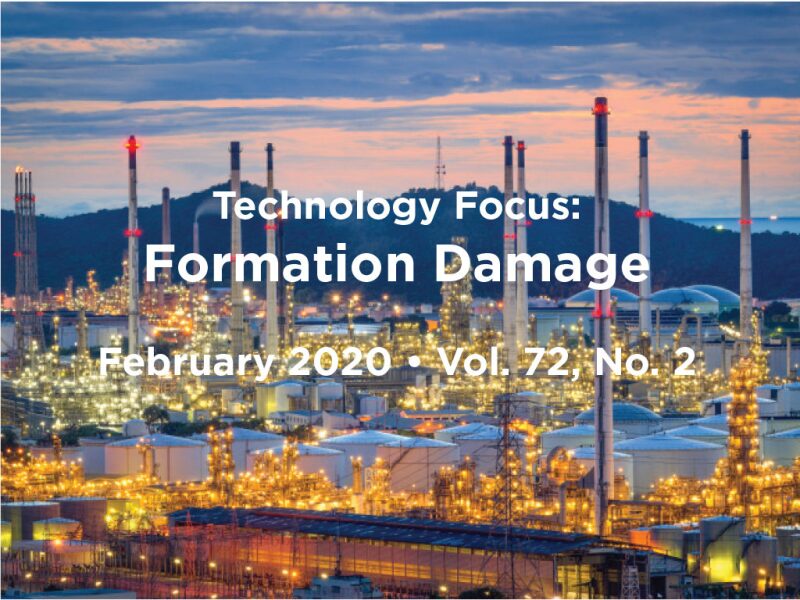One of the frustrating aspects of well-productivity analysis is identifying the causes of lower-than-expected productivity index (PI) during initial well lifetime. We are presented with a well that has a higher initial skin than expected with concomitant lower PI. Our task is to evaluate the multivariate aspects of well design, drilling and completion fluid design, geological characteristics (e.g., clay mineral type and abundance), permeability variation, net-to-gross ratio, and kh product among many other variables. The data are plotted, and we attempt to identify trends, if any. Out of all of this, we eventually come to the most-likely damaging mechanism (e.g., significant mud losses to the formation because of a poorly designed particle-size distribution or ineffective wellbore cleanup).
Alternatively, the completion can be damaged, the most common mechanism of which, in a well completed with screens, is plugging. The key expression here is “likely damaging mechanism,” because we have no actual way of going downhole and identifying at close range the actual damaging mechanisms. Brant Bennion’s definition of formation damage, which I like to quote, aptly summarizes the conundrum when he said that it was “the impairment of the invisible.” A further complication is the situation where two or more damaging mechanisms are operating concurrently. For example, the previous examples of mud losses to the formation combined with screen plugging can contribute in the same well to lower the PI and increase the skin. However, we have no way of identifying which of these is the most significant factor in explaining the observed well productivity or, in fact, if they are contributory factors in the first place. Inference is the only tool we have, and even that is fraught with inaccuracy.
Coreflooding can be used to determine the potential causes of formation damage by replicating the fluid sequence used in the damaged well. However, it is nonquantitative with regard to simulation of damaging effects along the production interval, especially if these are not uniformly distributed within a heterogeneous reservoir (i.e., in such cases, a coreflood represents a specific point along the production interval rather than representing the entire length).
Reduced well productivity during later well lifetime is generally a result of a different set of damaging mechanisms than those seen in initial production. Damaging mechanisms typical for mid- to late-life wells include fines mobilization, scale, and asphaltene formation. A few years ago, I was involved in a mud-acid stimulation intervention where we were convinced that the explanation for reduced productivity in this well was fines mobilization (kaolinite). Many corefloods had been performed on this particular formation that showed kaolinite could mobilize under scaled-down reservoir flow rates. For the particular candidate well, we pumped diesel to see if we could flush kaolinite from the near wellbore and saw an increase in productivity for a few days before the PI returned to its previous value. Corefloods were performed to qualify mud acid and showed positive results. The intervention was planned thoroughly and executed as expected. However, when the well was started, the PI was the same as before the intervention. Formation damage can be so frustrating.
Enjoy the papers I have selected, some of which touch on the comments I have made.
This Month's Technical Papers
Diagnostic Tool Identifies Factors in Well-Productivity Decline
Test Methodology Optimizes Selection of Fluids for Gasfield Development
Integrated Approach Identifies Formation Damage in Unfavorable Conditions
Recommended Additional Reading
SPE 197974 Raising the Bar of Productivity Improvement in an Abnormal and Distinctive Pressure and Temperature Environment: Niger Delta by Oyeintonbra Imbazi, Shell, et al.
SPE 189562 Laboratory Preparatory Work of Cased-Hole Cleanup as Part of an Entire Remedy Program in Removing Damage Attributed to Oil-Based Mud by Hideharu Yonebayashi, INPEX, et al.
OTC 28666 Completion-Fluids-Induced Formation Damage in High-Temperature Gas Wells: Causes and Mitigation by Bilel Hamzaoui, Saudi Aramco, et al.

| Niall Fleming, SPE, is a specialist in production technology with Equinor in Bergen, Norway. He has worked previously as a production geologist, chemist, and engineer. During the past few years, Fleming has worked as a leading adviser for well productivity and stimulation and as lead production engineer for the North Komsomolskoye project in Siberia. His main interest is within the area of formation damage from drilling and completion fluids and in wells under production. Fleming holds a PhD degree in geology from Imperial College London. He has authored several SPE papers, is an associate editor for SPE Production & Operations, serves on the JPT Editorial Committee, and has been a member of the organizing committees for several SPE conferences and workshops. In 2015, Fleming was awarded the SPE A Peer Apart award, and he is a four-time recipient of SPE’s outstanding technical editor award. He can be reached at nfle@equinor.com. |


